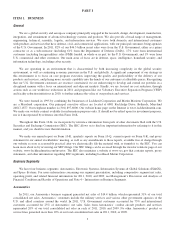Lockheed Martin 2011 Annual Report Download - page 21
Download and view the complete annual report
Please find page 21 of the 2011 Lockheed Martin annual report below. You can navigate through the pages in the report by either clicking on the pages listed below, or by using the keyword search tool below to find specific information within the annual report.we may have disputes with our subcontractors, teammates, or venture members, including disputes regarding the quality and
timeliness of work performed, the workshare provided to that party, customer concerns about the other party’s performance,
our failure to extend existing task orders or issue new task orders, or our hiring of the personnel of a subcontractor,
teammate, or venture member, or vice versa. In addition, the contracting parties on which we rely may be affected by
changes in the economic environment and constraints on available financing to meet their performance requirements or
provide needed supplies on a timely basis. A failure by one or more of those contracting parties to provide the agreed-upon
supplies or perform the agreed-upon services on a timely basis may affect our ability to perform our obligations. Contracting
party performance deficiencies may affect our operating results and could result in a customer terminating our contract for
default. A default termination could expose us to liability and affect our ability to compete for future contracts and orders.
The funding and costs associated with our pension and postretirement medical plans may cause our earnings, cash
flows from operations, and stockholders’ equity to fluctuate significantly from year to year.
Many of our employees are covered by defined benefit pension plans, and we provide certain health care and life
insurance benefits to eligible retirees. The impact of these plans on our GAAP earnings may be volatile in that the amount of
expense we record for our postretirement benefit plans may materially change from year to year because those calculations
are sensitive to changes in several key economic assumptions, including interest rates, rates of return on plan assets, and
workforce demographics. Changes in these factors affect our plan funding, cash flow, earnings, and stockholders’ equity.
With regard to cash flow, in the past few years we have made substantial cash contributions to our plans following
ERISA and in 2011, Pension Protection Act (PPA) requirements. We generally are able to recover these costs related to our
plans as allowable costs on our U.S. Government contracts, including FMS, but there are delays between when we contribute
cash to the plans under pension funding rules and recover it under government cost accounting rules. In December 2011, the
cost accounting rules were revised to harmonize the measurement and period assignment of the pension cost allocable to
government contracts with the PPA, which will reduce this delay starting in 2013 (CAS Harmonization). The cost impact of
CAS Harmonization will be phased in beginning in 2013 with the goal of better aligning the CAS cost and ERISA funding
requirements being fully achieved in 2017.
In recent years, we have taken certain actions to mitigate the effect of our defined benefit pension plans on our financial
results, including no longer offering a defined benefit pension plan to new, non-represented employees starting in 2006, and
making substantial cash contributions to the existing plans to improve their funded status. In 2011, we contributed
$2.3 billion to our defined benefit pension plans. For more information on how these factors could impact earnings, financial
position, cash flow and stockholders’ equity, see “Critical Accounting Policies – Postretirement Benefit Plans” in
Management’s Discussion and Analysis of Financial Conditions and Results of Operations and Note 10 – Postretirement
Benefits.
If we fail to manage acquisitions, divestitures, and other transactions successfully, our financial results, business, and
future prospects could be harmed.
In pursuing our business strategy, we routinely conduct discussions, evaluate targets, and enter into agreements
regarding possible acquisitions, divestitures, joint ventures, and equity investments. We seek to identify acquisition or
investment opportunities that will expand or complement our existing products and services, or customer base, at attractive
valuations. We often compete with others for the same opportunities. To be successful, we must conduct due diligence to
identify valuation issues and potential loss contingencies, negotiate transaction terms, complete and close complex
transactions, and manage post-closing matters (e.g., integrate acquired companies and employees, realize anticipated
operating synergies, and improve margins) efficiently and effectively. Acquisition, divestiture, joint venture, and investment
transactions often require substantial management resources and have the potential to divert our attention from our existing
business. Unidentified pre-closing liabilities could affect our future financial results.
Joint ventures or equity investments operate under shared control with other parties. Under the equity method of
accounting for nonconsolidated joint ventures and investments, we recognize our share of the operating results of these
ventures in our results of operations. Our operating results may be affected by the performance of businesses over which we
do not exercise control. The most significant impact of our equity investments is in our Space Systems business segment
where approximately 25% of its 2011 operating profit was derived from its equity investments in two joint ventures (see
“Space Systems” above). Management closely monitors the results of operations and cash flows generated by these
investees.
13
























